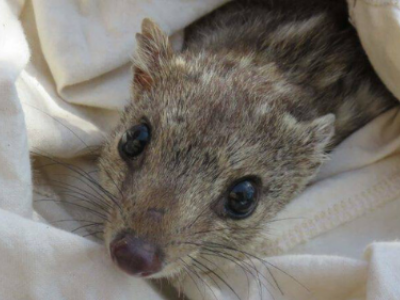14 February 2020

image © Amanda Hancock
The unprecedented 2019/20 Australian bushfire season has burned an estimated 15.6 million acres and killed an estimated 1 billion animals[efn_note]Samuel, S (2020), A staggering 1 billion animals are now estimated dead in Australia’s fires, Vox.com, accessed 18 February 2020, https://www.vox.com/future-perfect/2020/1/6/21051897/australia-fires-billion-animals-dead-estimate[/efn_note].
The scale of devastation is almost too hard to comprehend.
Indeed, as Dickman et. al. (2020) recently said:
“The wildfires were beyond anything anticipated in conservation planning and management for Australian biodiversity.”[efn_note]Dickman, C., Driscoll, D., Garnett, S., Keith, D., Legge, S., Lindenmayer, D., Maron, M., Reside, A., Ritchie, E., Watson, J., Wintle, B., Woinarski, J. (2020), After the catastrophe: a blueprint for a conservation response to large-scale ecological disaster, Threatened Species Recovery Hub, accessed 18 February 2020, http://www.nespthreatenedspecies.edu.au/_images/Projects/After%20the%20catastrophe%20report_V5.pdf[/efn_note]
According to the Australian Bureau of Meteorology[efn_note]Commonwealth of Australia 2018, Bureau of Meteorology, State of the Climate 2018, accessed 18 February 2020, http://www.bom.gov.au/state-of-the-climate/State-of-the-Climate-2018.pdf[/efn_note], Australia has seen a long-term increase in the risk of fires and a lengthening bushfire season due to climate change, particularly in the southeast. Winter rainfall has been decreasing in the southeast, while the country has been becoming hotter with more extreme heatwaves.
While the recent focus has understandably been on saving wildlife bushfire victims and the recovery of critical breeding and feeding habitat*, we mustn’t forget about wildlife outside the bushfire zones who need our help more than ever.
If anything, the catastrophic events highlight a necessity for stronger environmental laws and measures to better protect and conserve our native wildlife and vital habitats.
Conserving and protecting Queensland’s native wildlife for future generations
In 2020, Wildlife Queensland’s conservation programs will focus on enhancing and building community awareness of native wildlife, restoring vital wildlife habitat and surveying and monitoring of conservation-significant species in South Eastern Queensland. Projects include:
- 5th year of eDNA platypus surveys across South Eastern Queensland
- supporting our Scenic Rim Branch to create vital wildlife corridors in the Scenic Rim
- nest box installation and monitoring for greater gliders at Sheep Station Creek Conservation Park in Caboolture
- weed infestation clearing to improve and increase foraging habitat for an important colony of brush-tailed rock wallabies in the Flinders-Goolman Conservation Estate
- a series of detection dog surveys to search for spotted-tailed and northern quoll in the Mary Valley and Flinders Peak to Karawatha Corridor.
WPSQ’s quest to save endangered spotted-tailed quoll and northern quoll
In late 2019, Wildlife Queensland’s Quoll Seekers Network was awarded $33,540 under the State Government’s Community Sustainability Action Grants Program to engage a wildlife detection dog team to survey for quoll in the Mary Valley, South Eastern Queensland.
The detection dog surveys will be conducted in conjunction with infrared camera monitoring surveys.
The surveys will determine if spotted-tailed quoll or northern quoll still inhabit the Mary Valley and will help to inform and support the land management actions necessary to conserve South Eastern Queensland’s quolls.
“Quoll populations are under genuine threat of extinction in South Eastern Queensland,” says Wildlife Queensland’s Projects Manager, Matt Cecil.
“Using the scent detection dogs enables Wildlife Queensland to survey a wide area with a very high likelihood of detecting quolls if they have moved through the survey location at some time in the past.
“A better understanding of where quoll populations still remain in South Eastern Queensland and especially within connected forests of the Mary Valley provides Wildlife Queensland with opportunities to discuss and implement conservation actions with relevant landholders, land managers and natural resource management groups,” Matt says.
The detection dog surveys will kick off in Winter 2020.
Opportunities to get involved
Quoll Discovery Days:
Wildlife Queensland’s Quoll Seekers Network will hold two Quoll Discovery Days in May and June respectively, to enhance and build community awareness of both spotted-tailed and northern quoll.
The events will provide the Mary Valley community with information resources that include ways that rural landholders can contribute to the conservation of both quoll species (and other wildlife) on their own property.
Surveys and data collection:
There will also be opportunities for the community to be involved in scientific surveys and data collection for the two quoll species in the Mary Valley.
- An Atlas of Living Australia ‘Bio-Collect’ project will be created to enable Mary Valley residents to report quoll sightings.
- Interested volunteers from within the community will be invited to participate in the detection dog surveys.
Stay tuned! Further information and updates will be provided on the Quoll Seekers Network web page and in the my.Wildlife e-bulletin.
*Editor’s note: Wildlife Queensland wishes to acknowledge and thank all the incredible men and women involved in the rescue and care of wildlife in bushfire-affected areas as well as our members and friends for their concern and support.
